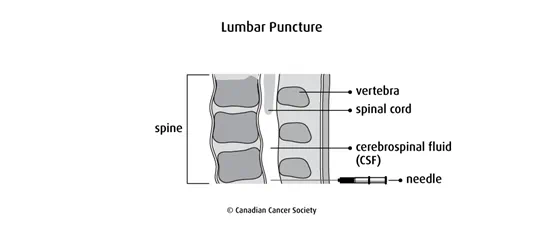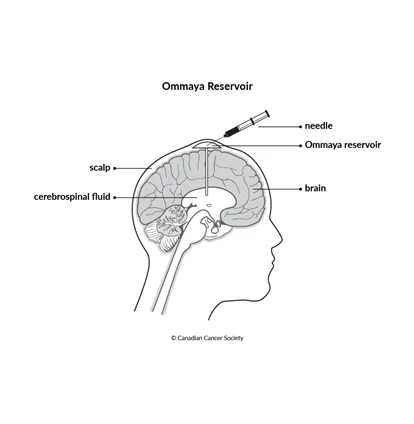Chemotherapy for childhood brain and spinal cord tumours
Chemotherapy uses drugs to destroy cancer cells. These drugs target rapidly dividing cells throughout the whole body. This means that chemotherapy kills cancer cells but it can also damage healthy cells.
With most types of chemotherapy, the drugs travel through the blood to reach and destroy cancer cells all over the body, including cells that may have broken away from the primary tumour. This is described as systemic therapy. Sometimes chemotherapy is used as a regional therapy for a specific area of the body.
Chemotherapy is sometimes used to treat childhood brain and spinal cord tumours. Your child's healthcare team will use what they know about the cancer and about your child's health to plan the drugs, doses and schedules.
Chemotherapy is often used along with other treatments. It may be used:
- to destroy cancer cells left behind after surgery or radiation therapy and reduce the risk that the cancer will come back (recur) (called adjuvant chemotherapy)
- to shrink a tumour before other treatments such as surgery or radiation therapy (called neoadjuvant chemotherapy)
- instead of radiation therapy to treat a tumour in children younger than 3 years of age
Chemotherapy and
Chemotherapy may affect how puberty develops in children. It can eventually affect their fertility, which is the ability to get pregnant or get someone pregnant. If possible, talk to the healthcare team about the treatment plan and fertility options before treatment begins.
How the drugs are given
Systemic drugs used to treat childhood brain and spinal cord tumours may be given by mouth (orally) or by a needle in a vein (intravenous injection). Usually a special device called a central venous catheter is used to safely give the drugs. It is often put in place at the start of chemotherapy and left until treatment is finished. Find out more about a central venous catheter.
Many chemotherapy drugs can't cross the
Intrathecal chemotherapy
Chemotherapy may be given through a lumbar puncture into the space around the spinal cord containing the CSF.

Intraventricular chemotherapy
Chemotherapy for brain tumours may be given directly into the CSF in the ventricles of the brain. It is given through an Ommaya reservoir, which is a small, dome-shaped device with a short tube (catheter) attached to it that is placed during surgery. The chemotherapy drug is injected using a small needle inserted through the scalp into the Ommaya reservoir.

Glial wafers
With some types of brain tumours, the area where the tumour was removed is lined with special wafers (glial wafers or Gliadel). These wafers have concentrated doses of the drug carmustine (BiCNU, BCNU), which is released into the brain tissue as the wafers break down.
This method of chemotherapy delivers a concentrated amount of the chemotherapy drug to the area where the tumour was in the brain, while limiting the number of normal cells in the body affected by the drug.
Chemotherapy drugs used for childhood brain and spinal cord tumours
The most common chemotherapy drugs for childhood brain and spinal cord tumours include:
- cyclophosphamide
- cisplatin
- etoposide (Vepesid)
- carboplatin
- carmustine (BiCNU, BCNU)
- lomustine (CeeNU, CCNU)
- methotrexate
- temozolomide (Temodal)
- high-dose methotrexate
- vincristine
- ifosfamide (Ifex)
- vinblastine
- procarbazine (Matulane)
- thiotepa (Tepadina)
- irinotecan (Onivyde)
- bleomycin
Side effects
Side effects of chemotherapy will depend mainly on the drug, the dose, how it's given and your child's overall health. Tell the healthcare team if your child has any side effects you think might be from chemotherapy. The sooner you tell them of any problems, the sooner they can suggest ways to help your child.
Possible side effects of chemotherapy for childhood brain and spinal cord tumours include:
- hair loss
- sore mouth
- loss of appetite
- nausea and vomiting
- diarrhea
- low blood cell counts (bone marrow suppression)
- low white blood cell count
- infection
- low platelet count
- anemia
- fatigue
- constipation
- nerve damage
- hearing loss
- kidney damage
- allergic reactions
Other side effects can develop months or years after treatment for brain and spinal cord tumours. Find out more about late effects of treatments for childhood brain and spinal cord tumours.
Find out more about chemotherapy
Find out more about chemotherapy and side effects of chemotherapy. To make the decisions that are right for your child, ask the healthcare team questions about chemotherapy.
Details on specific drugs change regularly. Find out more about sources of drug information and where to get details on specific drugs.
